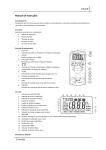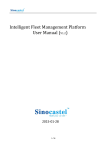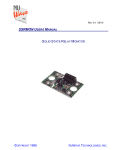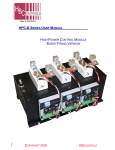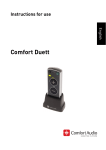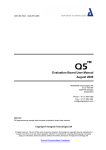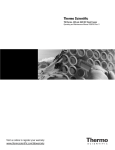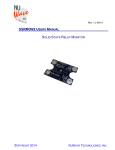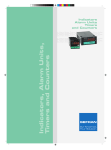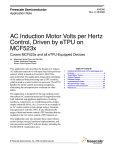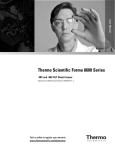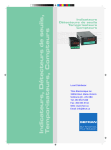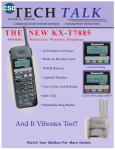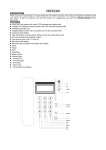Download NWIPCM-1P User Manual
Transcript
Rev.1.3 01/11 NWIPCM-1P SERIES USER MANUAL PHASE ANGLE SCR POWER CONTROL DRIVER BOARD FOR INDUCTIVE LOADS COPYRIGHT 2011 NUWAVE TECHNOLOGIES, INC. NWIPCM-1P User Manual TABLE OF CONTENTS 1. 2. 3. Ordering Codes ................................................................................................................... 2 Description .......................................................................................................................... 3 Installation / Safety Information ........................................................................................... 3 3.1 Mounting Instructions ................................................................................................... 4 3.2 Electrical Connections ................................................................................................. 4 3.3 SCR Output Snubbers and Transient Protection ......................................................... 4 3.3.1 Commutation Problems ........................................................................................ 4 3.3.2 dv/dt Problems ...................................................................................................... 4 3.3.3 Snubber Sizing ..................................................................................................... 4 3.3.4 MOVs and TVSs ................................................................................................... 4 3.4 Limited Warranty .......................................................................................................... 5 4. Operation ............................................................................................................................ 5 4.1 Power Supply ............................................................................................................... 5 4.2 Power Fusing ............................................................................................................... 5 4.3 Command Input ........................................................................................................... 5 4.4 PWM Command Input .................................................................................................. 5 4.4.1 Input Fail-safe Protection ...................................................................................... 6 4.5 Line Voltage Compensation ......................................................................................... 6 4.5.1 Line Voltage Compensation Nominal Adjustment ................................................. 6 4.6 Soft Change ................................................................................................................. 6 4.6.1 Current Limit & Soft Change ................................................................................. 7 4.7 Soft Start ...................................................................................................................... 7 4.8 Voltage Limit ................................................................................................................ 7 4.8.1 Voltage Limit Adjustment Procedure ..................................................................... 7 4.9 Current Feedback / Current Limit ................................................................................. 8 4.9.1 Current Transformer Input .................................................................................... 8 4.9.2 Current Limit Adjustment Procedure ..................................................................... 8 4.10 Configuration Dipswitch ............................................................................................... 9 4.11 Indicator LEDs ............................................................................................................. 9 4.11.1 Power LED............................................................................................................ 9 4.11.2 SCR1&2 Drive LEDs ............................................................................................. 9 4.11.3 Current Limit LED ................................................................................................. 9 4.11.4 Load Fault LED ..................................................................................................... 9 4.12 Three Phase Operation .............................................................................................. 10 5. Fault Outputs..................................................................................................................... 10 5.1 Load Fault Outputs .................................................................................................... 10 5.2 Aux Alarm Outputs ..................................................................................................... 10 6. Current Retransmit Output ................................................................................................ 10 7. Electrical Specifications .................................................................................................... 11 7.1 SCR Gate Drive Profile .............................................................................................. 11 7.2 Input Specifications .................................................................................................... 11 7.3 Output Specifications ................................................................................................. 11 7.3.1 Mechanical Dimensions ...................................................................................... 12 8. WIRING DIAGRAM - SINGLE PHASE.............................................................................. 13 9. Contact Information ........................................................................................................... 13 1. Ordering Codes Copyright 2011 NUWAVE TECHNOLOGIES, INC. NWIPCM-1P User Manual Ordering Codes NWIPCM-1P-___-___-___ Inductive Load Power Control Module Single Pole Phase Angle 120 or 240 PWR -XSS (Softstart Time, seconds) -XSC (Soft Change Time, seconds) (1 sec Soft Change is the default) -LIV (Linear RMS Voltage) (Linear RMS Power is the default) Example: NWIPCM-1P-120-1SC = Inductive Load Phase Angle Control Module, RMS power output, 120V PWR, 1 sec soft change. (this is the default configuration if the NWIPCM-1P-XXX is ordered). 2. Description The NWIPCM-1P is a Phase Angle SCR Power Control Driver Board designed for use with high power back to back SCR modules driving resistive or inductive loads. The power delivered to the load is proportional to the command input signal. The gate drive technique used in the NWIPCM is DC drive for the greatest stability for firing inductive loads. Features: Provides true linear power or linear voltage output phase angle control Command input accepts 4-20mA, 0-10V, 0-5V, Pot, PWM Configurable line voltage compensation increases stability of your process Configurable soft start / soft change for high inrush loads Automatic 50/60Hz operation (47 to 63Hz) Adjustable Voltage Limit Current feedback and Adjustable Current Limit Load and SCR fault Detection Drives SCR gates directly with DC drive Single phase and three phase control 3. Installation / Safety Information Responsibility for determining suitability for use in any application / equipment lies solely on the purchaser, OEM and end user. Suitability for use in your application is determined by applicable standards such as UL, cUL and CE and the completed system involving this component should be tested to those standards. WARNING: FIRE HAZARD!! Even quality electronic components CAN FAIL KEEPING FULL POWER ON! Provide a SEPARATE (redundant) OVER TEMPERATURE SHUTDOWN DEVICE to switch the power off if safe temperatures are exceeded. Copyright 2011 NUWAVE TECHNOLOGIES, INC. NWIPCM-1P User Manual WARNING: HIGH VOLTAGE!! This control module / board has high voltage on it that can cause death. This control must be installed in a GROUNDED enclosure by a qualified electrician in accordance with applicable local and national codes including NEC and other applicable codes. Provide a safety interlock on the door to remove power before gaining access to the device. 3.1 Mounting Instructions The NWIPCM-1P mounts using six spacers or using nylon PCB clips such as Panduit CBLS50-C or Richco LCBS-8-01. See the mechanical dimensions section for more details. The PCB should be mounted at least 0.500” from any surface. 3.2 Electrical Connections See the WIRING DIAGRAMS at the end of this document. Make sure the module ordered is the correct module for the application before wiring. Before wiring the module all Dip Switch settings for the command input and special features should be setup properly per the Dipswitch Configuration Section. 3.3 SCR Output Snubbers and Transient Protection 3.3.1 Commutation Problems When an SCR or TRIAC is used to control an inductive load, the load current lags the mains voltage. When the device turns off at zero current, the rate of rise of the reapplied voltage can retrigger the device and produce half cycling and blown fuses. To limit this rate of rise and obtain reliable commutation, an R-C (resistor–capacitor) snubber circuit should be connected in parallel with the SCR/TRIAC. 3.3.2 dv/dt Problems When voltage transients occur on the mains supply or load of an SCR/TRIAC it can cause the device to turn on unexpectedly due to the fast rate of rise of voltage (dv/dt). This can result in false firing and half cycling of the load that can cause blown fuses when driving inductive loads. An R-C snubber circuit will help to limit the dv/dt seen by the device and will produce more reliable firing. 3.3.3 Snubber Sizing When an SCR/TRIAC using an R-C snubber turns on, the capacitor is discharged through the resistor into the device resulting in high peak currents. It is critically important when sizing your snubber to make sure that the resistor value does not become so low that the ratings of the SCR/TRIAC are exceeded when the capacitor is discharged. 3.3.4 MOVs and TVSs Copyright 2011 NUWAVE TECHNOLOGIES, INC. NWIPCM-1P User Manual Metal Oxide Varistors and Transient Voltage Suppressors are both used on TRIACS/SCRs to “clamp” voltage spikes that can occur across the devices and damage them. Snubbers are not a substitute for MOVs/TVSs and vice versa. Snubbers and MOVs/TVs should be used together to get reliable performance and long life from the SCR/TRIAC application. External MOV must be installed across SCRs to limit peak voltages seen by the NWIPCM to ~ 850VDC. 3.4 Limited Warranty NuWave Technologies, Inc. warrant this product to be free from defect in workmanship and materials for a period of two (2) years from the date of purchase. 1. Should unit malfunction, return it to the factory. If defective it will be repaired or replaced at no charge. 2. There are no user serviceable parts on this unit. This warranty is void if the unit shows evidence of being tampered with or subjected to excessive heat, moisture, corrosion or other misuse / misapplication. 3. Components which wear or damage with misuse are excluded, e.g. relays. 4. NuWave Technologies, Inc. shall not be responsible for any damage or losses however caused, which may be experienced as a result of the installation or use of this product. NuWave Technologies, Inc. liability for any breach of this agreement shall not exceed the purchase price paid E. & O.E. 4. Operation 4.1 Power Supply The NWIPCM-1P power supply requirement is 120 or 240VAC +/-10% 47-63Hz. The line synchronization for the phase angle firing is derived from the power supply input. 4.2 Power Fusing A 500mA user serviceable fuse is provided. Under normal circumstances this fuse should not open. If it does, it means that one of the following conditions exists: 1. A large power line transient occurred. 2. The NWIPCM-1P was wired incorrectly, or the wrong line voltage unit was ordered. 3. The NWIPCM-1P malfunctioned and requires service. 4.3 Command Input The NWIPCM-1P can accept 4-20mA, 0-10V, 0-5V, and Potentiometer and PWM inputs. All analog commands are isolated from the power line and SCR drive outputs. The type of command input can be configured via the dipswitch. The default setting is 05V/potentiometer. The PWM digital command input (PLC Interface) is isolated from the power line and SCR drive outputs, but not from the other board I/O. Any leg of the command input can tolerate shorts to the (0V) input. Connecting the power to any part of the command input or SCR drive outputs will cause damage to the unit. 4.4 PWM Command Input Copyright 2011 NUWAVE TECHNOLOGIES, INC. NWIPCM-1P User Manual The NWIPCM-1P PWM Command input is designed to accept a signal from a PLC or a process/temperature controller’s SSR drive output. This logic signal is used to generate a command setpoint. The PWM input has two + inputs (PWM+ and PWMH+). The PWM input leg should be used for 5V logic drive. The PWMH input leg should be used for 24V logic drive. There are two dipswitch settings for the PWM input, PWMF (fast) and PWMS (slow). The PWMF should be selected for 250Hz to 15KHz PWM. The PWMS should be selected for 10Hz (100mS Cycle Time) to 250Hz PWM signals. The PWM input is not isolated from the other low voltage I/O. 4.4.1 Input Fail-safe Protection If the signal sent to the NWIPCM-1P’s command input should become electrically open the control output will be forced to an off state. 4.5 Line Voltage Compensation The NWIPCM-1P‘s line voltage compensation keeps the power constant on the load as the line voltage changes. The line voltage is measured via the 120 or 240V power applied to the NWIPCM-1P module. Line Voltage Compensation can be enabled or disabled using the configuration dipswitch. The default setting is enabled (Switch # 3 is OFF). To disable the Line Voltage Compensation, set switch # 3 to the ON position. With a 10% drop in lin e voltage, N WIPCM-1P load power drops less th an 2% (120V, 1KW, 14.4 O h m Load ) With ou t Lin e Voltage Compen sation N WIPCM-1P Lin e Voltage Compen sation 120VAC 120VAC 108VAC (-10%) 108VAC (-10%) MAINS VOLTAGE 1KW MAINS VOLTAGE 1KW P= E R LOAD POWER LOAD POWER 0.81KW (~-20%) 4.5.1 Line Voltage Compensation Nominal Adjustment The nominal adjustment pot sets the nominal level of output for the current line voltage being measured. This should be adjusted so that with 100% command applied, the output is just able to achieve full power (98%). 4.6 Soft Change Copyright 2011 NUWAVE TECHNOLOGIES, INC. NWIPCM-1P User Manual The soft change feature limits how quickly the output can change value. For inductive loads such as transformers, soft change is always required because it prevents inrush current associated with DC accumulation and saturation of the transformer. Soft Change can be set on or off using the configuration dipswitch # 7. The default setting is off. Soft change times below or above one second are available and can be ordered by adding a XSC to the ordering code where X is the time in seconds. 4.6.1 Current Limit & Soft Change The current can be used with soft change. If Current Limit and soft change are selected, the 1 seconds (or special ordered soft change time “-XSC”) will be applied with current limit. 4.7 Soft Start The Soft Start feature ramps up to the command value over a period of approximately 1 second. If soft start is ordered, the soft start time resets if the command value goes to zero (less than 4% of the input range) or power is cycled. Soft start is useful on high inrush heaters such as Quartz, Molybdenum, Tungsten, or Graphite heaters. Soft Start can be set on or off using the configuration dipswitch # 7. The default setting is off. Soft start times below or above one second are available and can be ordered by adding a “–XSS” to the ordering code where X is the time in seconds. Soft Start Period High Inrush Load Soft Start used to limit the inrush Current Current The Soft Start ramps the voltage up slowly over the soft start period. Time Time 4.8 Voltage Limit The Voltage Limit feature is used in conjunction with the Line Voltage Compensation feature to limit the actual voltage delivered to the load. The Voltage Limit is adjustable via the on board adjustment potentiometer. For this feature to work properly Line Voltage Compensation must be turned on (Switch # 3 OFF). This feature can be used without Line Voltage Compensation and will simply clip the command signal to a set level. 4.8.1 Voltage Limit Adjustment Procedure Copyright 2011 NUWAVE TECHNOLOGIES, INC. NWIPCM-1P User Manual The Voltage Limit is adjustable from 0% to 100% of the max load voltage. Setting the Voltage Limit potentiometer half way corresponds to a power limit of approximately 50% or a voltage limit of 70% of the max load voltage. The best way to set the voltage limit is using a voltmeter connected across the load. With the command input set to approximately 100% (on startup) turn the pot fully CCW. Then just turn the pot CW until the desired output voltage is achieved. For this feature to work as a true voltage limit, it is important that the Line Voltage Compensation be enabled (this is the OFF position of Switch # 3). If the line voltage compensation is set to OFF the voltage limit will act as a percentage of output limit and the absolute voltage limit will change with line voltage. When the NWIPCM-1P is actively holding back or “limiting” the command via voltage limit, the RED “LIM ON” LED will become energized. 4.9 Current Feedback / Current Limit When the Current Limit feature is enabled (Dipswitch # 8 set to on) and the current transformer wired per the Current Transformer Input section, the NWIPCM-1P will allow the maximum current to be set via the Current Limit Potentiometer. The range of adjustment of the Current Limit potentiometer is 10 - 110% of full scale load current (110% = OFF, when the pot is turned fully clockwise). The full scale load current is defined by the CT turns ratio described in the Current Transformer Input section. 4.9.1 Current Transformer Input The NWIPCM-1P requires a current transformer to be wired to the CT1 and CT2 terminals to provide current feedback for the Current Limit and Load Fault detection features. The CT input has a full scale of 200mA RMS, and 5V peak. For the best accuracy, the current transformer turns ratio should be chosen according to the maximum current of the controlled load as follows: CT Turns Ratio Max Measured Current (full scale load current) 1:500 100A RMS 1:1000 200A RMS 1:2000 400A RMS 1:4000 800A RMS 1:5000 1000A RMS Other combinations of primary and secondary turns ratios may be used as long as the 200mA RMS and 5V peak of the CT input are not exceeded. 4.9.2 Current Limit Adjustment Procedure The Current Limit is adjustable from 10% to 100% of the full scale current. Setting the Current Limit potentiometer half way corresponds to a current limit of approximately 50% of full scale. The best way to set the current limit is using a true RMS current clamp meter on the load circuit. With the command input set to approximately 100% (on startup) turn the current limit pot fully CCW. Then just turn the pot CW slowly until the desired max output on the clamp meter current is observed. The output current will be limited to the read current within +/-5% of full scale. Copyright 2011 NUWAVE TECHNOLOGIES, INC. NWIPCM-1P User Manual When the NWIPCM-1P is actively holding back or “limiting” the load current, the RED “LIM ON” LED will become energized. If the current limit LED begins to blink, the current transformer input is overloaded. Overload occurs if the peak current goes beyond the ratings of the CT input. This will affect the accuracy of the current limit and if the indicator blinks continuously the NWIPCM-1P module may become damaged. 4.10 Configuration Dipswitch The configuration dipswitch is used for setting up the command input, line voltage compensation, soft start and current limit. Using a pen point gently push the switch up for on and down for off according to the setup outlined in the table below. Command Input 0-5V (Default) Potentiometer 0-10V 4-20mA 1-5V 2-10V PWMF (Fast) PWMS (Slow) 1 OFF OFF OFF OFF OFF OFF OFF ON 2 OFF OFF ON OFF OFF ON OFF OFF Feature to Enable None Line Voltage Comp Enabled (default) Soft Start / Soft Change Enabled Current Limit 4 OFF OFF OFF OFF OFF OFF ON ON 3 ON OFF 5 OFF OFF OFF ON OFF OFF OFF OFF 7 6 OFF OFF OFF ON ON ON OFF OFF 8 ON ON 4.11 Indicator LEDs 4.11.1 Power LED The Green Power LED will illuminate when power is applied. 4.11.2 SCR1&2 Drive LEDs The RED SCR Drive LEDs will turn on when the SCR drive output is on and increase in intensity as the power output is increased. If the SCR gate is not wired properly or not connected, the LED will not illuminate. Because the drive signal varies considerably to give linear power output, the LED should only be used as a rough indication of SCR Drive and not actual power output. 4.11.3 Current Limit LED The RED Current Limit LED will illuminate when the current limit is actively limiting the load current. 4.11.4 Load Fault LED Load detection requires a current transformer to be wired to the CT1 and CT2 terminals. Copyright 2011 NUWAVE TECHNOLOGIES, INC. NWIPCM-1P User Manual The RED Load Fault LED will illuminate when an imbalance between the positive and negative half cycles exists or a shorted SCR is present. 4.12 Three Phase Operation Three NWIPCM-1Ps can be used to control three poles of a three phase load for inside delta, or grounded WYE configurations. 5. Fault Outputs 5.1 Load Fault Outputs The open collector load fault output is energized when a load fault condition exists (when the load fault led is on). 5.2 Aux Alarm Outputs The Alarm output is a custom configured option. 6. Current Retransmit Output The Current Retransmit output is designed to be a relative indication with +/-10% of full scale accuracy. The output is 0-5V from 0-100% of the full scale load current. Copyright 2011 NUWAVE TECHNOLOGIES, INC. NWIPCM-1P User Manual 7. Electrical Specifications 7.1 SCR Gate Drive Profile 200nS Rise Time (~6A/uS) 1.2Amps Peak 160mA ~50uS Width Gate current maintained through conduction period SCR Gate Drive Profile 7.2 Input Specifications Command Inputs Input Impedance Response Time PWM Input Frequency PWM Input Level PWM Vinlow (+/-20%) PWM Vinhigh (+/-20%) CT Input Range External Potentiometer Res. Command to Mains Isolation Command to SCR Drive Isolation 4-20mA, 0-10V, 0-5V, Pot, PWM 10K (0-10V), 250 (4-20mA), 100K (0-5V) <50mS 10Hz-15KHz 5 VDC @ 4mA or 24VDC @ 10mA (both non isolated) 2.3VDC (PWML terminal), 5.2VDC (PWMH terminal) 3.5VDC (PWML terminal), 7.8VDC (PWMH terminal) 0-200mAAC (0-5VAC) 1K -25K 2500Vrms 2500Vrms 7.3 Output Specifications Control Range Output Linearity Line Voltage Comp. Range Regulation Soft Change Period Current Limit Range Voltage Limit Range Ambient Temperature Range Power Supply Line Frequency Range SCR Gate Drive Characteristics Open Collector Alarm Outputs 0-5V Current Retransmit SCR Drive / Mains Isolation Copyright 2011 1 – 98% power +/-2% +10%/-10% up to 100% output +/-2% 1 seconds to reach 100% output (default) 10-110% (110% = OFF) 0-100% of max load voltage 0 to 50 °C 120 or 240VAC +10/-10%, 100mA max. 47 to 63Hz Initial pulse peak current of 1.2A rise time of ~200nS, maintain current of 160mA; See the SCR gate drive profile section for more detail. 50mA / 28VDC Max 0-5V, 2.5K output impedance 2500Vrms NUWAVE TECHNOLOGIES, INC. NWIPCM-1P User Manual 7.3.1 Mechanical Dimensions Copyright 2011 NUWAVE TECHNOLOGIES, INC. NWIPCM-1P User Manual 8. WIRING DIAGRAM - SINGLE PHASE 9. Contact Information NuWave Technologies, Inc 866-379-3597 www.nuwaveproducts.com Copyright 2011 NUWAVE TECHNOLOGIES, INC.














